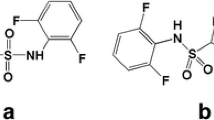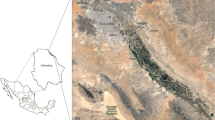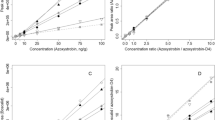Abstract
The aim of the current study was to track the composition, spatial and temporal distribution charactistics of triazine herbicides in arable soils and corns in typical agricultural regions of Liaoning Province, China. All samples were analyzed using high performance liquid chromatography-tandem mass spectrometry (HPLC-MS/MS). Twelve kinds of triazine herbicides were found including atrazine, simazine, prometryn, propazine, ametryn, metribuzin, simetryn, aziprotryne, cyanizine, atrazine-desethyl, atrazine-desisopropyl and atrazine-desethyl-desisopropyl in the soil samples, of which atrazine, simazine, prometryn, atrazine-desethyl and atrazine-desethyl-desisopropyl were proved to be the predominant species with a high incidence though relatively low contamination level. The maximum concentration of atrazine in the soils was 73.80 µg·kg−1. Five kinds of triazine herbicides were found in corns in the region including atrazine, simazine, prometryn, atrazine-desethyl and atrazine-desethyl-desisopropyl with the detection rate 96.4%, 17.8%, 14.3%, 60.7% and 46.4%, respectively. The maximum contaminant level of atrazine in corns was 12.52 µg·kg−1, which is lower than that regulated in the National Standard of the People’s Republic of China (GB2763-2012).





Similar content being viewed by others
References
Ackerman F (2007) The economics of atrazine. Int J Occup Environ Health 13:437–445
Baranowska I, Barchanska H, Pyrsz A (2005) Distribution of pesticides and heavy metals in trophic chain. Chemosphere 60:1590–1599
Barchanska H, Sajdak M, Szczypka K, Swientek A, Tworek M, Kurek M (2017) Atrazine, triketone herbicides, and their degradation products in sediment, soil and surface water samples in Poland. Environ Sci Pollut Res 24:644–658
Brun GL, MacDonald RM, Verge J, Aube J (2008) Long-term atmospheric deposition of current-use and banned pesticides in Atlantic Canada: 1980–2000. Chemosphere 71:314–327
Chen LW, Hu XX, Yang Y, Jiang CL, Bian C, Liu C, Zhang MY, Cai TM (2018) Degradation of atrazine and structurally related s-triazine herbicides in soils by ferrous-activated persulfate: kinetics, mechanisms and soil-types effects. Chem Eng J 351:523–531
Giusi G, Facciolo RM, Canonaco M, Alleva E, Belloni V, Dessi-Fulgheri F, Santucci D (2006) The endocrine disruptor atrazine accounts for a dimorphic somatostatinergic neuronal expression pattern in mice. Toxicol Sci 89:257–264
Hvezdova M, Kosubova P, Kosikova M, Scherr KE, Simek Z, Brodsky L, Sudoma M, Skulcova L, Sanka M, Svobodova M, Krkoskova L, Vasickova J, Neuwirthova N, Bielska L, Hofman J (2018) Currently and recently used pesticides in Central European arable soils. Sci Total Environ 613–614:361–370
Islam K, Chand R, Han D, Kim YS (2015) Microchip capillary electrophoresis based electroanalysis of triazine herbicides. Bull Environ Contam Toxicol 94:41–45
Jablonowski ND, Koppchen S, Hofmann D, Schaffer A, Burauel P (2009) Persistence of 14C-labeled atrazine and its residues in a field lysimeter soil after 22 years. Environ Pollut 157:2126–2131
Jablonowski ND, Schaffer A, Burauel P (2011) Still present after all these years: persistence plus potential toxicity raise questions about the use of atrazine. Environ Sci Pollut Res 18:328–331
Li YZ, Zhang R, Wang HT, Duan HA, Wang M, Li T, Yao YL, Zhang CW (2009) Determination of multi-residues of triazine herbicides residues in rice by HPLC-tandem MS/MS. J Instrumental Anal 28:315–318
Lin Z, Zhen Z, Liang YQ, Li J, Yang JW, Zhong LY, Zhao LR, Li YT, Luo CL, Ren L, Zhang DY (2019) Changes in atrazine speciation and the degradation pathway in red soil during the vermiremediation process. J Hazard Mater 364:710–719
Liu Y, Ma LY, Lu YC, Jiang SS, Wu HJ, Yang H (2017) Comprehensive analysis of degradation and accumulation of ametryn in soils and in wheat, maize, ryegrass and alfalfa plants. Ecotoxicol Environ Safe 140:264–270
Moreno MT, Rodriguez-Amaro R, Rodriguez Mellado JM, Mayen M, Jimenez Guardeno F (2018) Imidazolinone and triazine herbicides in soils in relation to the complexes formed with Cu(II) ions. C R Chim 21:884–889
Morgante V, Lopez-Lopez A, Flores C, Gonzalez M, Gonzalez B, Vasquez M, Rossello-Mora R, Seeger M (2010) Bioaugmentation with Pseudomonas sp. strain MHP41 promotes simazine attenuation and bacterial community changes in agricultural soils. FEMS Microbiol Ecol 71:114–126
Morgante V, Flores C, Fadic X, Gonzalez M, Hernandez M, Cereceda-Balic F, Seeger M (2012) Influence of microorganisms and leaching on simazine attenuation in an agricultural soil. J Environ Manage 95:S300–S305
Nodler K, Licha T, Voutsa D (2013) Twenty years later-atrazine concentrations in selected coastal waters of the Mediterranean and the Baltic Sea. Mar Pollut Bull 70:112–118
Panshin SY, Carter DS, Bayless ER (2000) Analysis of atrazine and four degradation products in the pore water of the Vadose Zone, Central Indiana. Environ Sci Technol 34:2131–2137
Qin X, Liu Y, Huang Q, Liu YY, Zhao LJ, Xu YM (2019) In-situ remediation of cadmium and atrazine contaminated acid red soil of South China using sepiolite and biochar. Bull Environ Contam Toxicol 102:128–133
Rodriguez-Gonzalez N, Uzal-Varela R, Gonzalez-Castro MJ, Muniategui-Lorenzo S, Beceiro-Gonzalez E (2017) Reliable methods for determination of triazine herbicides and their degradation products in seawater and marine sediments using liquid chromatography-tandem mass spectrometry. Environ Sci Pollut Res 24:7764–7775
Rohr JR, Sager T, Sesterhenn M, Palmer BD (2006) Exposure, postexposure, and density-mediated effects of atrazine on amphibians: breaking down net effects into their parts. Environ Health Perspect 114:46–50
Sassine L, Le Gal La Salle C, Khaska M, Verdoux P, Meffre P, Benfodda Z, Roig B (2017) Spatial distribution of triazine residues in a shallow alluvial aquifer linked to groundwater residence time. Environ Sci Pollut Res 24:6878–6888
Scherr KE, Bielsk L, Kosubov P, Dinisov P, Hvezdova M, Simek Z, Hofman J (2017) Occurrence of chlorotriazine herbicides and their transformation products in arable soils. Environ Pollut 222:283–293
Sousa AS, Duavi WC, Cavalcante RM, Milhome MAL, do Nascimento RF (2016) Estimated levels of environmental contamination and health risk assessment for herbicides and insecticides in surface water of ceara, Brazil. Bull Environ Contam Toxicol 96:90–95
Sun J, Ma XL, Wang W, Zhang J, Zhang H, Wang YJ, Feng J (2019) The adsorption behavior of atrazine in common soils in northeast China. Bull Environ Contam Toxicol 103:316–322
Ye CM, Gong AJ, Wang XJ, Zheng HH, Lei ZF (2001) Distribution of atrazine in a crop-soil-groundwater system at Baiyangdian Lake area in China. J Environ Sci-China 13:148–152
Zou N, Yuan CH, Liu SW, Han YT, Li YJ, Zhang JL, Xu X, Li XS, Pan CP (2016) Coupling of multi-walled carbon nanotubes/polydimethylsiloxane coated stir bar sorptive extraction with pulse glow discharge-ion mobility spectrometry for analysis of triazine herbicides in water and soil samples. J Chromatogr A 1457:14–21
Acknowledgements
This work was supported by the National Natural Science Foundation of China (21775005, 41430641), China Geological Survey (1212011120287), Liaoning BaiQianWan Talents Program (2019921009) and Key Scientific Research Program of Anshan Normal University (16kyxm01) from Anshan Normal University.
Author information
Authors and Affiliations
Corresponding author
Additional information
Publisher’s Note
Springer Nature remains neutral with regard to jurisdictional claims in published maps and institutional affiliations.
Electronic supplementary material
Below is the link to the electronic supplementary material.
Rights and permissions
About this article
Cite this article
Wang, X., Liu, Q. Spatial and Temporal Distribution Characteristics of Triazine Herbicides in Typical Agricultural Regions of Liaoning, China. Bull Environ Contam Toxicol 105, 899–905 (2020). https://doi.org/10.1007/s00128-020-03049-8
Received:
Accepted:
Published:
Issue Date:
DOI: https://doi.org/10.1007/s00128-020-03049-8




